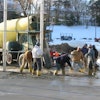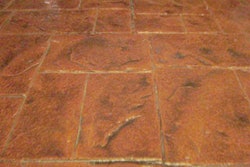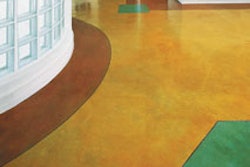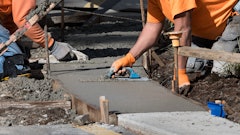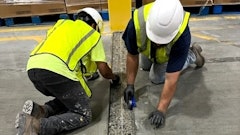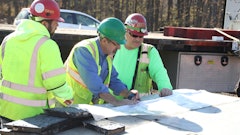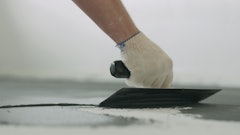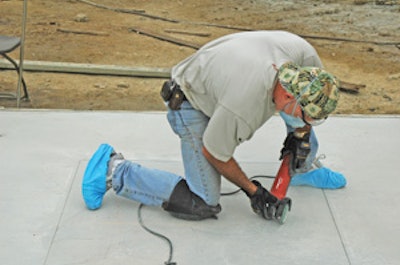
A safety may be OK in football but safety is no game in this industry.
Recently while teaching a chemical staining class at our facility, I did not practice what I was preaching. During our classes we emphasize the importance of protecting yourself as well as your employees. The last day of our class my friend was mentioning a problem with the pump sprayer that contained acid stain. When he pulled the sprayer from the bucket that it was in, the trigger hit the side of the bucket and locked the trigger to the on position spraying stain in my face.
Needless to say I did not have my safety goggles or glasses on. Fortunately I was able to turn away in time and the little bit of stain that did get in my eyes was flushed with eyewash from our first aid kit. I have heard of stories such as this time and time again and felt compelled to write about the importance of safety.
For many of us, it is all too easy to get caught up in the creative side of the decorative business while glossing over the safety aspects of a project. Don't do it! Not only can a disregard of safety procedures be harmful to you and your employees, you may also be putting other trades, building occupants and even our environment at risk. This oversight can be extremely costly, resulting in fines from OSHA. More importantly, it can seriously jeopardize your or your employees' health.
Safety starts with a comprehensive jobsite safety program and putting someone in charge of overseeing it. This person should keep abreast of all safety rules and regulations, conduct routine safety meetings and talks with employees, monitor safety compliance and make sure the appropriate Material Safety Data Sheets are available at all times. When you are on an actual jobsite it is obviously important to focus on the work at hand but also pay attention to what's happening around you. Watch for situations that could lead to disaster such as an open flame, like a lit cigarette, while working around a flammable substance. It's imperative that you or a designated safety person scans the entire project site at all times. Let's review some of the key issues:
- Take precautions when working with solvents. Many sealers along with some coloring agents are solvent-based, which are extremely flammable and also hazardous to breath. It is imperative to keep any source of open flame such as space heater, pilot light and cutting tools or lit cigarettes contained throughout the entire application process. When working indoors make sure the area is well ventilated and try to always keep air moving, simply by opening windows for a cross draft.
- Airborne cement dust either from mixing materials or cutting concrete is hazardous to breathe. Make sure and wear the appropriate respirator to protect your lungs. Cement is very caustic and can cause severe skin burns even after brief contact. Always protect your skin from direct contact with cement. When working with concrete or cement-based products, wear the appropriate eye protection to protect from splatter.
- Check extension cords to make sure they are properly grounded and have no cut or frayed sections. Make sure your cords and equipment are not being used around water. When using power equipment, always follow the recommended safety procedures for operation and wear the proper safety gear such as safety glasses, work gloves and ear protection.
- Protect your knees from wear and tear by wearing kneepads whenever you are kneeling while working. This may be one of the most overlooked safety considerations in our industry. Many of my co-workers have had to undergo surgery because they worked for prolonged periods on their knees without wearing adequate knee protection.
- When lifting heavy objects, learn to lift properly. Bags or buckets of material can be heavy and when not lifted properly, can easily throw your back out. Lift with your legs instead of bending over and lifting with your back. Make it mandatory for your employees to wear a back belt support, which also helps with improper lifting.
- Many decorative concrete workers I have worked with don't care to wear hard hats. On most commercial projects it is mandatory to wear them. If this is the case, put them on!
- Make sure you have safe access when delivering your raw or mixed materials from the mixing station to the application site. Make sure no obstacles are in the way. I have seen instances where a worker slipped or fell while pushing a wheelbarrow or buggy because the floor was slippery or a stray object on the floor became a tripping hazard. I heard of one contractor's employee actually breaking his ankle from an unclear path.
- If using tools that require handles while installing your decorative concrete, be aware of any overhead electrical wires. Try and avoid using aluminum handles and use fiberglass handles.
These are just some basic considerations on the subject of safety. Take safety related issues seriously. You can only protect the well-being of yourself and your employees by implementing a safety program and creating a safe working environment.
Bob Harris is the founder and president of the Decorative Concrete Institute, Douglasville, Ga., which provides hands-on training seminars in architectural concrete. For more information, call (877) DCI-8080 or visit www.decorativeconcreteinstitute.com.


